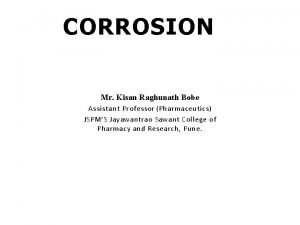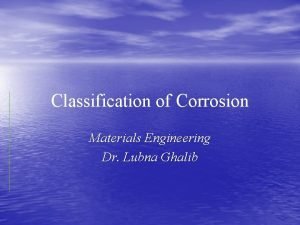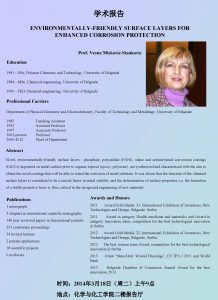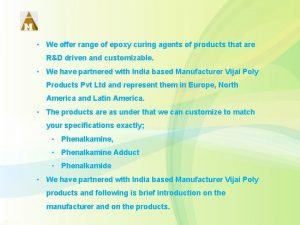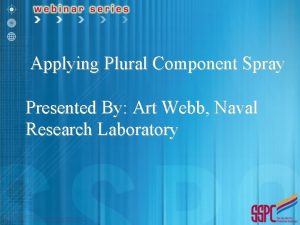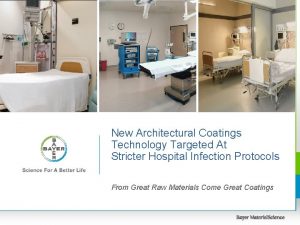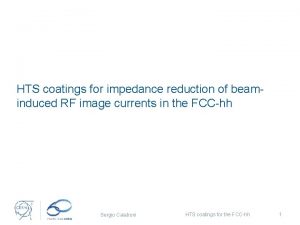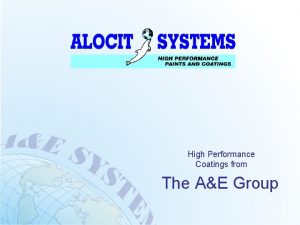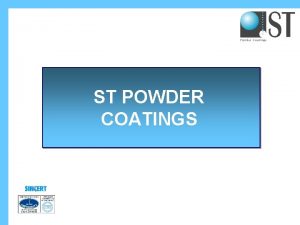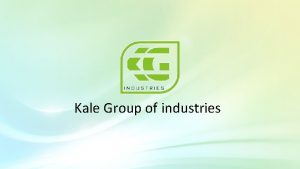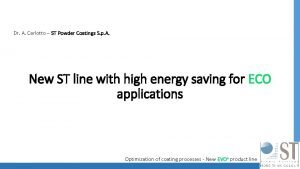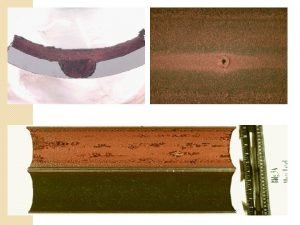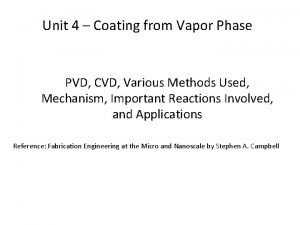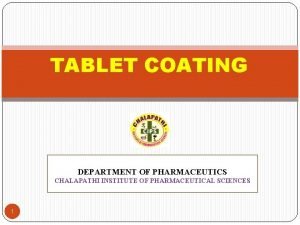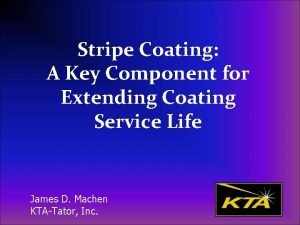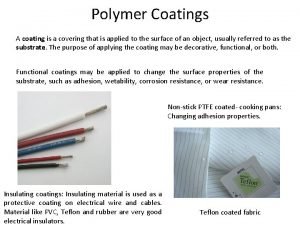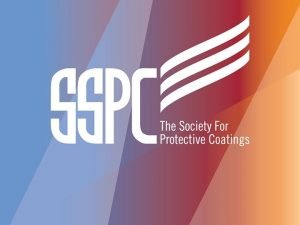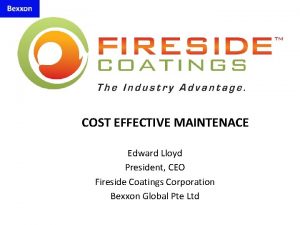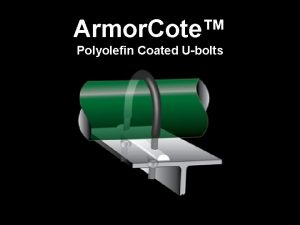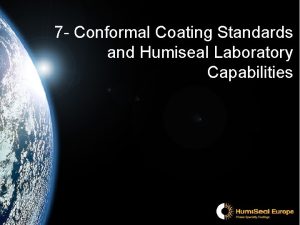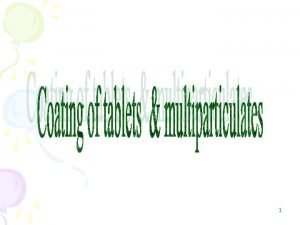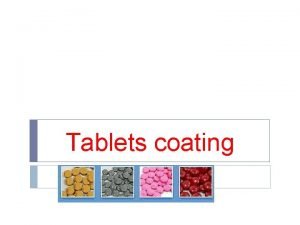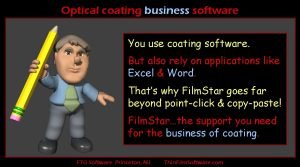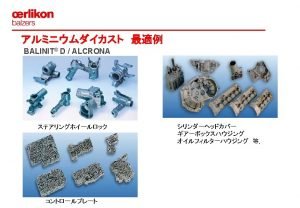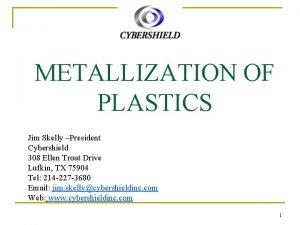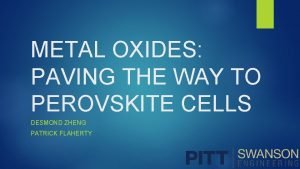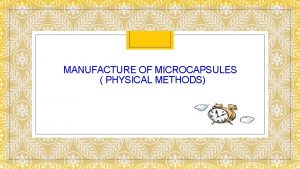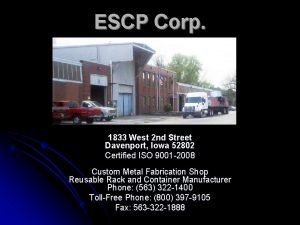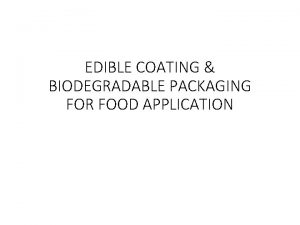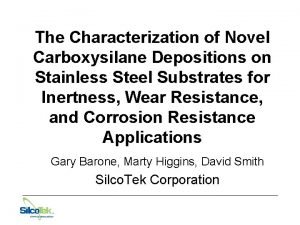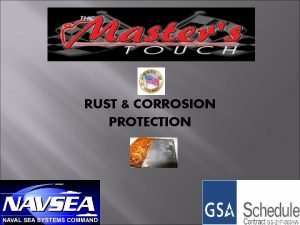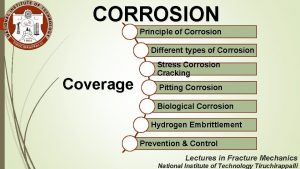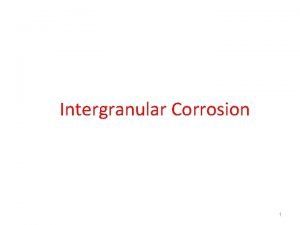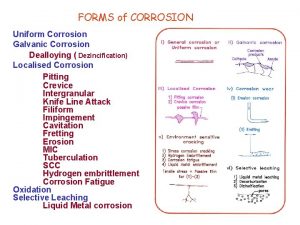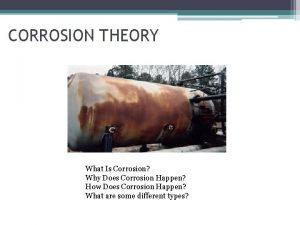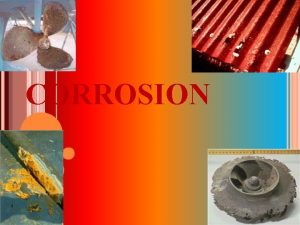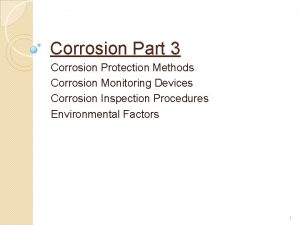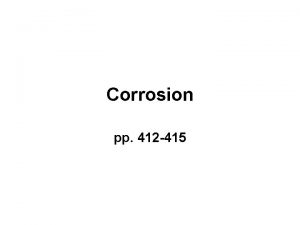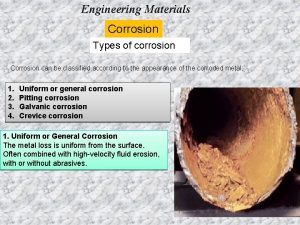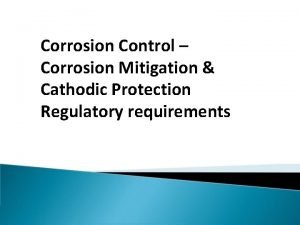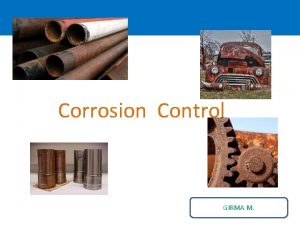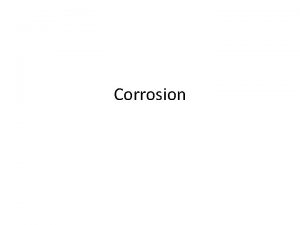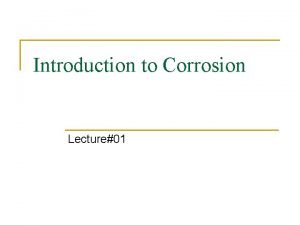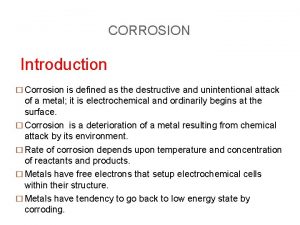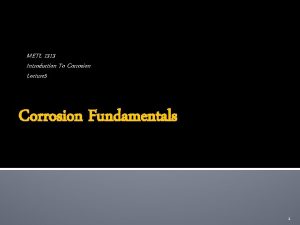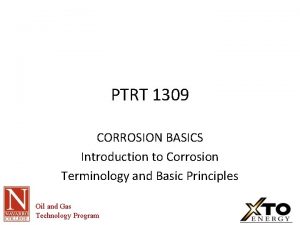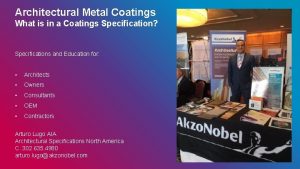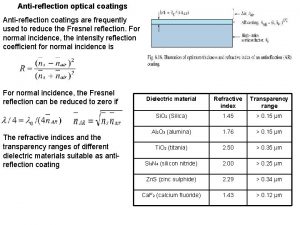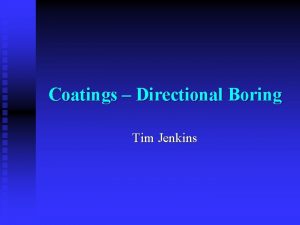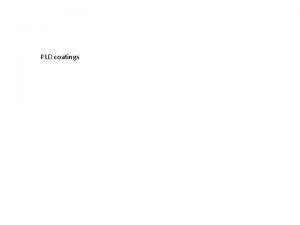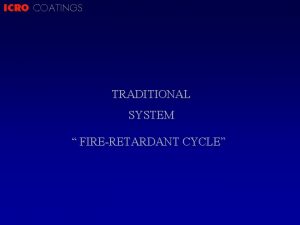Introduction to Corrosion Control and Coatings and Coating






























- Slides: 30

Introduction to Corrosion Control and Coatings and Coating Types

Topics • Coating system selection • Coating components • Curing mechanisms of coatings • Elements of a coating system • Coating types

Selecting a Coating System • Mission of system • Service environment • Substrate • Environmental and occupational health considerations

Service Environments to Consider • Temperature • Likelihood and type of physical damage • Surrounding operations • Prevailing environment (e. g. saltwater mist) • Biological life

Basic Components of a Coating • Solvent • Resin (Binder) • Pigments • Additives • Low % of overall makeup

Components of a Coating Non-Volatile Components • Remain on surface • Include: • Resin (Binder) • Pigments • Additives Volatile Components • Evaporate from coating into atmosphere • Include: • Solvent system included in paint wet film

Resin (Binder) Definition Properties • Adhesion • Film-forming; nonvolatile component of a coating • Compatibility with different coatings • Ease of application, topcoating, and repair • Performance in different environments

Pigment Definition • Heavier, solid; nonvolatile component of a coating Properties • Opacity (Hiding) • Color • Inhibitive corrosion resistance • Level of gloss • Reinforcement • Wet paint properties • Weather and moisture resistance

Solvent Primary Solvents Secondary Solvents • Formulated in coating to reduce viscosity of resin, pigment, and additives for ease of application • Formulated to stay in wet film, because a slower evaporation helps the coating to flow -out and knit together • This relationship is necessary for a uniform, continuous film

Curing Mechanism Definition Types of Mechanisms • Solvent evaporation • Method by which a coating converts from a liquid to a solid state • Chemical reaction of components (Polymerization) • Moisture cure • Heat and UV cure

Solvent Evaporation Definition • Coatings that form protective films by simple evaporation of organic solvent Coating Examples • Vinyls • Acrylics • Chlorinated rubbers

Chemical Reaction of Components (Polymerization) Definition Coating Examples • Coatings that cure by chemical reaction of multiple components • Epoxies • A ratio that is specified by the manufacturer is provided to obtain a film with optimum properties • Polyureas • Polyurethanes • Polyesters/vinyl esters • Phenolics • Silicones (Polysiloxanes)

Moisture Cure Definition • Reaction of a coating with moisture in a process known as hydrolysis Coating Examples • Single-component polyurethanes • Inorganic zinc coatings

Heat and UV Cure Definition • Heat or ultraviolet light reacts with resin, causing a chemical reaction and subsequent cure of the coating film • Heat may also be used to accelerate coating cure Coating Examples • Powder coatings • Specialty coatings

Coating System Stackup • Consists of multiple coatings that are compatible with one another and used to create a system • Example: • Pretreatment • Epoxy (Primer) • Polyurethane (Topcoat)

Functions of Coating Components • Pretreatment • Improves coating adhesion and promotes corrosion protection • Primer • Bond coating system to the substrate • Provide corrosion protection to the substrate using barrier membrane, inhibitive, galvanic, or combination of the three • Topcoat • First line of defense in terms of corrosion • Aesthetics • Color • Gloss • Compatible with primer

Coating Types • Conversion coatings • Pretreatment wash primer • Epoxies • Polyurethanes (single- and two-component) • Waterborne acrylic • Polyurea • Polysiloxane

Conversion Coating • Chrome and Non-chrome options • Often incorrectly referred to as Alodine • Increases corrosion resistance of aluminum • Promote strong adhesion properties • Applied with either a “wipe-on” and “blot-off” method or a disposable application pen • Apply according to manufacturer’s product data sheet

Conversion Coatings Advantages • Promotes adhesion • Provides some corrosion protection Limitations • Can contain hazardous materials • Hexavalent chromium • Fast-drying Hexavalent chromium is an excellent corrosion inhibitor but is a known human carcinogen Must apply appropriate engineering controls during application, removal, and disposal

Pretreatment Wash Primers • Alternative to conversion coatings • Two-component product • Similar to a vinyl • Components react with each other and with metal to form a tightly adhering film • Commonly used to promote adhesion and corrosion protection

Pretreatment Wash Primers Advantages • Promotes adhesion of some primers • Provides temporary corrosion protection • Fast-drying Limitations • High VOCs • Limited uses • Film may undergo cohesive failure when applied too thickly

Epoxies Advantages • Good solvent, water, and chemical resistance • Good abrasion resistance • Good adhesion • Rapid cure time Limitations • Limited pot life • Chalk in sunlight • Limited flexibility • Amine blush • Strict surface preparation

Two-Component Polyurethanes Aliphatic • Better weathering characteristics • Color • Gloss • Used as Topcoat on Exteriors Aromatic • Chemical Resistance • Chalk and yellow in sunlight

Two-Component Polyurethanes Advantages Limitations • Water resistance • Highly toxic (isocyanates) • Hardness or flexibility • Moisture-sensitive • Durability/abrasion resistance • Limited pot life • Lower temp curing achievable

Waterborne Acrylic Coatings Advantages Limitations • Lower VOC • Limited durability • Easy application • Fast drying • Poor chemical and solvent resistance • Low odor • Poor wetting of surface • Low cost • Poor immersion service • Safer • Best cured above 50°F • Flexibility

Two-Component Polyureas Advantages • No VOC • Low odor • Low permeability • Resistant to various solvents, caustics and mild acids • Excellent bond strength • Weather-tolerant Limitations • Difficult application due to short pot life • Highly toxic (isocyanates) • Weight

Polysiloxanes Advantages Limitations • Low VOCs • Shorter pot life • Cure without the use of isocyanates • Brittleness • Color and gloss retention • Good abrasion resistance • Good weatherability • Film-thickness sensitive

Powder Coatings Advantages • Excellent abrasion resistance and hardness • Very low VOC Disadvantages • Difficult to repair/touch-up • Thin coatings are hard to achieve • Part has to be grounded • Oven size

Coatings and Coating Types Summary • Factors that contribute to the satisfactory performance of a protective coating include surface preparation or application characteristics, resistance to exposure conditions, safety and environmental considerations, and maintainability. • While some coating types are clearly best for certain uses, each coating type has its advantages and disadvantages.

Agenda • Corrosion Basics • Fundamentals of Corrosion Control • Surface Preparation for Coatings • Coatings and Coating Types • Coating Application and Safety • Coating Defects and Inspection
 Differentiate between dry corrosion and wet corrosion
Differentiate between dry corrosion and wet corrosion Differentiate between wet and dry corrosion
Differentiate between wet and dry corrosion Corrosion control solutions
Corrosion control solutions Phenalkamide
Phenalkamide Plural pump system
Plural pump system Hospital wall coatings
Hospital wall coatings Hts coatings
Hts coatings Alocit
Alocit Powder coating kildare
Powder coating kildare Kale group
Kale group St powder coatings
St powder coatings Sherwin williams chemical coatings store
Sherwin williams chemical coatings store Mechanism of wet corrosion
Mechanism of wet corrosion Chemical vapour deposition
Chemical vapour deposition Tablet opaquant
Tablet opaquant Stripe coat
Stripe coat Spin coating thickness equation
Spin coating thickness equation Coating application specialist
Coating application specialist Bfb boiler coating
Bfb boiler coating Teflon coated u bolts
Teflon coated u bolts Conformal coating standards
Conformal coating standards Enteric coated tablets definition
Enteric coated tablets definition Sugar-coated tablets examples
Sugar-coated tablets examples Color software
Color software Balinit futura
Balinit futura Spraylat copper conductive coating
Spraylat copper conductive coating Apex metal oxide coating
Apex metal oxide coating Coating pan slideshare
Coating pan slideshare Escp
Escp Edible coating definition
Edible coating definition Dursan coating
Dursan coating
